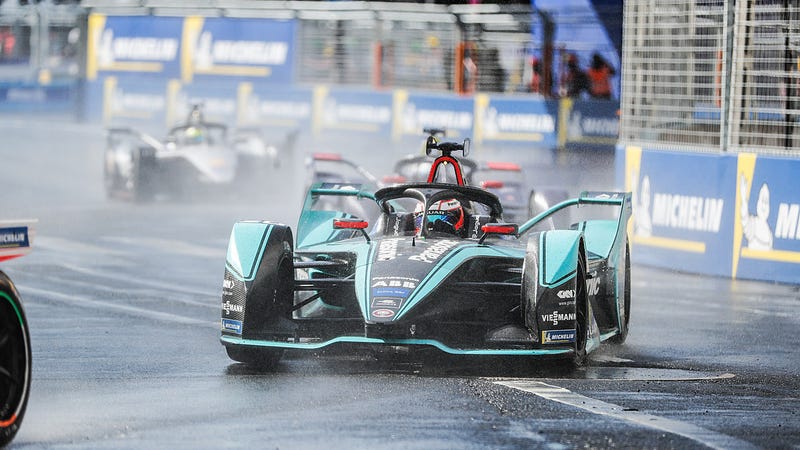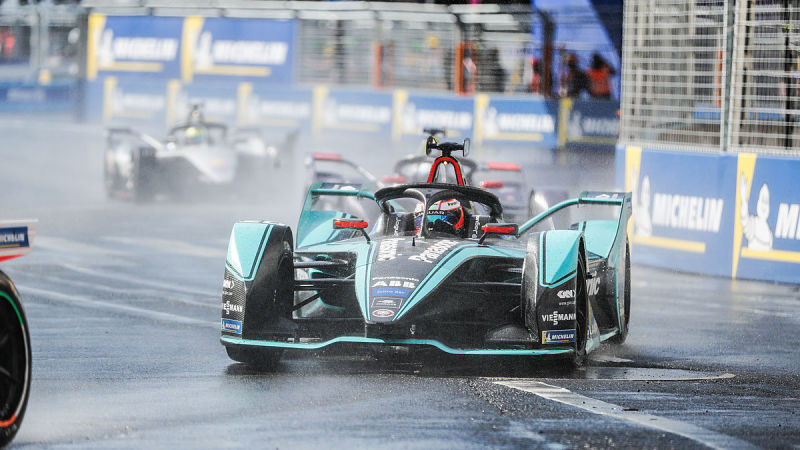
Getting on board with a brand-new racing series, especially one marketed as “world class” from the very start, can be hard. There’s already so much racing out there to watch, and so many drivers out there to follow, that it might not seem worth it to devote the time and energy to learning something completely new. Perhaps we’ve put Formula E, the all-electric open-wheel series, into that category without giving it enough of a chance to prove itself.
(Full disclosure: Nissan flew me to New York for Formula E, put me up in a Brooklyn hotel and provided a place to watch the race. They also paid for a couple of meals.)
Not that our collective skepticism wasn’t justified. The whole “FanBoost” thing felt silly and desperate, and it was hard to say whether an electric series—especially one where drivers had to swap cars midway through a race thanks to battery limitations—was on par with the stuff we already watch.
But racing fans, including yours truly, need to change that.
When Formula E came to Brooklyn for its first New York City E-Prix in 2017, three years into its existence as an FIA-sanctioned championship, it was a thirst trap pitched as the future of world-class racing and the car industry. Companies gave out VIP passes to anyone remotely involved with cars, or anyone remotely in the public eye, like fliers at career day, hoping that PR pitch would become the general consensus. We thought it felt like a marketing conference that happened to have a race attached.
Advertisement

Myself and a few other Jalopnik staffers attended that first race, too, and I remember waiting for the cars to approach the corner we were watching from but having no idea when they would because of their near-silent powertrains. When they did finally reach us, it wasn’t much of an event.
Advertisement
It wasn’t long before the field was out of sight again, our surroundings hushed from the faint whine of the cars to the wind and sounds of the Brooklyn Cruise Terminal. Most of the grandstand, including us, laughed. It wasn’t a mean laugh—it was a “What just happened?” one.
That wasn’t all. The circuit layout was suspiciously tight, leading us to wonder about top speeds, and we didn’t leave with a feeling that we watched a bunch of fast cars race. We felt like simply watched a bunch of cars race.
Advertisement

There were good things, like how telling it was to be able to hear every tire that slid across the racing surface or every car that slammed a curb, and there were bad things, like the confusion of not having assigned seats and the astronomical ticket prices for a series only a few years old. (That year, single-day tickets ran $85 for standard admission, $55 for students and $42.50 for children ages 5 to 15. IndyCar tickets for Sunday, Aug. 18 at Pocono Raceway, just over two hours from where the Formula E Brooklyn race is held, started at $45 for adults and free admission for kids 12 and under. Adult grandstand tickets for the NASCAR Cup Series race at Richmond Raceway in September start at $40.)
Advertisement
So, we left that race in 2017 with the idea that Formula E as a live-spectator event was, overall, fine. It wasn’t about to revolutionize the next generation of racing lovers or anything. For us, it felt like a startup company—like it had as equal of a chance of being the future as it did of falling apart in two years.
But this time around, in 2019, it didn’t give off that vibe. That seemed to be by virtue of both series and personal growth.
Advertisement

The Brooklyn doubleheader was the season finale last year and this year, with Sébastien Buemi and Robin Frijns winning the 2019 races while Jean-Éric Vergne took the drivers’ championship. New York won’t end the season next year, but will still host the penultimate race before the finale in London.
Advertisement
Everything felt more comfortable in New York this time, from the series in general to the competition. The quiet cars were more normal, two years and many more electric road cars (and plans for them) later. We as spectators didn’t hear the race start, and we weren’t supposed to. It wasn’t strange anymore.

Advertisement
Because it’s held in a purpose-built and deconstructed course in Red Hook, the layout for the Brooklyn race can’t be changed much without moving it entirely. That meant the circuit wasn’t too different this year than in 2017, with only slight tweaks to two corners: The eighth and ninth turns on the 2017 course got smoothed out, and the first turn on it changed from a hairpin to rectangular set of corners. The locations of pit lane and the start-finish line also changed.
But with Formula E’s second-generation race cars, the course didn’t bring with it that same suspicion of low velocities. Speeds went up with the move to the new-generation cars, going from numbers like Faraday Future Dragon Racing’s claimed 150-mph top speed before the 2016 season to Formula E’s claimed 174-mph top speed this season.
Advertisement
Sure, Juan Pablo Montoya hit nearly232 mph in an F1 car in 2005 and Cup Series drivers can easily get to 200 mph at some tracks, but bigger numbers are still better—even if they’re not quite to the 200 barrier yet.
Advertisement
The lack of mid-race car swaps due to improved battery life took away much of the clunkiness of Formula E, and the series’ new Attack Mode feature, unlike the “Fanboost” one that gives the top five drivers in a fan vote an extra burst of power during each race, adds back in some of the strategy lost from eliminating the need for those required pit stops. Car swaps were an element outside of the general racing where drivers and teams could easily mess up, and Attack Mode, which lets drivers get a power boost a certain amount of times per race while choosing the non-racing line, helps add that back in.
It seems gimmicky in writing, but with Formula E’s broadcast animations and the requirement for each driver to duck away from the racing line a specified number of times, it set up some incredible maneuvers on track while putting that extra bit of strategy, and entertainment, back into the race.
Advertisement
In any racing series there needs to be some element that can be royally screwed up outside of just making laps in a race, like a joker lap in rallycross or pit stops elsewhere. For Formula E, Attack Mode is it.
Advertisement
The racing alone, though, was wild. Cars regularly either smacked or slammed into each other in the turn-10 hairpin, sending the crowd into near-routine roars. Debris from collisions was mostly left on the circuit, probably because the race was on a time limit and yellow flags cut into that time, and that made cars have to dodge dismembered pieces of other cars as they went around. It was obvious that this was the end of the season, everyone was going for it, and no one cared who got in their way as they did.
Repeated carnage throughout an event shouldn’t be the norm in a series like Formula E, since that veers more into the “demolition derby” category than the racing one. The carnage is to the point that Formula E plans to make the front end of its cars less tough after next season, since the punishment for contact isn’t on the correct driver: Right now, one driver can punt another from behind and hurt that driver’s car without sacrificing their own. The idea is to make the front end more susceptible to “self punishment,” so that there’s less smacking from behind.
Advertisement
But even then, watching and hearing the cars bang against each other in New York got the entire crowd into the show. This is America, after all, and in America we believe that rubbing is racing.

Advertisement
The whole experience gave the impression that instead of trying too hard to be unique, Formula E is making its own niche in motorsports. Its Jaguar I-Pace eTrophy support series features electric SUVs that sometimes smash into walls and each other, and watching SUVs race on its own is a surreal thing.
Random techno beats pumped through the track speakers during and after the race, giving people something to listen to when cars were in front of them and when they weren’t. A beatboxer who simultaneously played the flute was in the entertainment lineup.
Advertisement
It was like a race out of some weird future where we all wear metallic clothing, smart contacts and jam to EDM in the streets, and where our rides to school are actual flying cars instead of drones pretending be them. But at the same time, it all felt right.
It’s made enough real progress that it’s absolutely worth watching now. It felt exactly how the world’s top electric racing championship should feel, from the racing to everything that went with it. And, if that’s still Formula E’s goal, the series sure is doing a good job at it.














